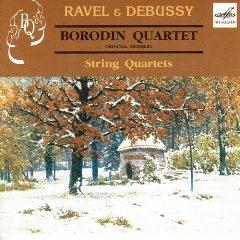Borodin Quartet – Ravel & Debussy (2005)
Borodin Quartet – Ravel & Debussy (2005)

Maurice Ravel 1. String Quartet In F Major: I. Allegro Moderato, Tres Doux 2. String Quartet In F Major: II. Assez Vif, Tres Rythme 3. String Quartet In F Major: III. Tres Lent 4. String Quartet In F Major: IV. Vif Et Agite Claude Debussy 5. String Quartet In G Minor, Op.10: I. Anime Et Tres Decide 6. String Quartet In G Minor, Op.10: II. Assez Vif Et Bien Rythme 7. String Quartet In G Minor, Op.10: III. Andantino, Doucement Expressif 8. String Quartet In G Minor, Op.10: IV. Tres Modere - Tres Anime Rostislav Dubinsky – violin Yaroslav Alexandrov – violin Dmitry Shebalin – viola Valentin Berlinsky – cello
The Borodins are a byword for quality in everything they do, and they have a habit of getting good recordings in addition. It is all here again, just like in the recordings of Shostakovich and of the eponymous Borodin that I already know from them. The playing has the familiar confidence, strength of characterisation, depth and quality of tone, unfailing stylistic grasp and unerring surefootedness that I am coming to know. The recording is first-rate again too, with depth and resonance at no cost to clarity. To hear just how good it can be, try the pizzicato chords at the start of the second movement of Debussy's quartet.
Tempi should give nobody any problem. They are very close indeed to those taken by the Parrenin quartet in a recording I have known and loved down the years but which seems not to be in the current catalogues, the most significant divergence being in the slow movement of the Ravel, taken much more slowly by the Borodins, and with great solemnity and effectiveness.
Both of these quartets are comparatively early works by their respective authors, but both, (Ravel's particularly), are accomplished and already characteristic. Accustomed as I am to the Parrenins I would not say that I find these accounts the last word in some elusive 'Frenchness', but that is not something that exercises me in the slightest. Composers and compositions of this stature transcend nationality, and this disc can be recommended without hesitation to lovers of the works and newcomers alike. ---David Bryson, amazon.com
The similarities between Maurice Ravel's only work for string quartet, the String Quartet in F major, and Claude Debussy's only work for string quartet, the String Quartet in G minor, Op. 10, can hardly be avoided or ignored. During the early years of his career, Ravel was frequently and sometimes vehemently criticized for having copied Debussy, and it was only later that musical society began to realize that, in the realm of piano music at least, it was equally possible that Debussy had imitated his younger colleague. With the String Quartet in F, composed in 1902 and 1903 and then revised up to 1910, however, Ravel seems more certain to have relied on Debussy's 1893 Op. 10; as emotionally, psychologically, and even structurally different as the two works are, one could never accuse them of having a language barrier. But, whereas Debussy's quartet is the work of a headstrong progressive still on his way to developing a mature, personal style, Ravel's is the work of an already mature artist more concerned with craftsmanship and traditional structure than with innovation. Not surprisingly, given their relative places in their careers when the two composers wrote their string quartets, Ravel's is the more sound piece of music and Debussy's is the more groundbreaking. Incidentally, Debussy, by all accounts, adored Ravel's piece, and though it makes the cut by just a couple of years, it is probably the most oft-played string quartet of the twentieth century. Ravel dedicated it to his teacher, Gabriel Fauré.
Ravel's String Quartet is in four movements: Moderato très doux, Assez vif-Très rythmé, Très lent, and Vif et agité. The opening movement's pianissimo second theme is as hollow and melancholy as the first theme is warm and inviting. In the second movement, which serves as the Quartet's scherzo, Ravel moves into the pizzicato world already explored by Debussy in the scherzo movement of his String Quartet; the central portion (one hesitates to call it a "trio section") calls for the players to put mutes on their instruments. Bits of music from earlier in the Quartet can be heard, wearing new clothes, in the slow movement; likewise in the finale, which plunges straight into a frantic 5/4 meter bombast at its start, lightens up in the middle, and then ends in a blaze of zeal. --- Blair Johnston. Rovi
download (mp3 @320 kbs):
yandex 4shared mega zalivalka cloudmailru uplea mediafire








